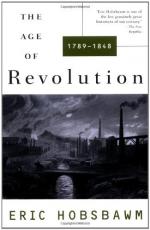
|
| Name: _________________________ | Period: ___________________ |
This test consists of 5 multiple choice questions, 5 short answer questions, and 10 short essay questions.
Multiple Choice Questions
1. How was the European population changing that made it possible for art to flourish during the Age of Revolution?
(a) The upper classes could travel to artistic centers to buy art.
(b) The upper classes had more disposable income.
(c) People were more literate.
(d) People were wealthier.
2. In Hobsbawm's account, what did the peasantry lose by land reforms sweeping the globe in the mid-1800s?
(a) Protections.
(b) Dependence on local government.
(c) Ambition.
(d) Freedom.
3. What was increasing at the same time that the railroads were expanding in the 1830s?
(a) Migration.
(b) Superstition.
(c) Monarchy.
(d) Religion.
4. Why were Jews particularly well-suited to take advantage of opportunities to join the new middle class?
(a) They were established financiers.
(b) They were already largely urbanized.
(c) They lived in centers of trade.
(d) They were typically well-versed in science and technology.
5. Who does Hobsbawm say typified the third kind of thinking that arose in the early 1800s?
(a) Goethe.
(b) Rousseau and Hegel.
(c) Coleridge.
(d) Wordsworth and Blake.
Short Answer Questions
1. How does Hobsbawm describe the traditional system of agriculture?
2. What was the consequence of British land reforms in India?
3. Where was Chartism an active part of the political landscape?
4. Why were the working poor treated with contempt as a new social structure evolved in Europe?
5. What fell away as industrialism developed in Europe?
Short Essay Questions
1. What role did religion serve, even as Europe was becoming more secular?
2. What examples does Hobsbawm cite to demonstrate his point that the arts were responsive to the socioeconomic conditions in Europe in the mid-1800s?
3. How does Hobsbawm define middle class ideology?
4. How does Hobsbawm describe the working class' living conditions?
5. Why was France's economy left behind, in Hobsbawm's account?
6. What happened in France while the rest of Europe was industrializing?
7. What are the three sources Hobsbawm refers to when he says that artists made the effects of industrialization a common theme?
8. What does Hobsbawm say was increasing around 1848?
9. What does Hobsbawm say was growing along with and as a result of Protestantism?
10. How did those in power react to the spread of middle class ideology, in Hobsbawm's account?
|
This section contains 739 words (approx. 3 pages at 300 words per page) |

|




